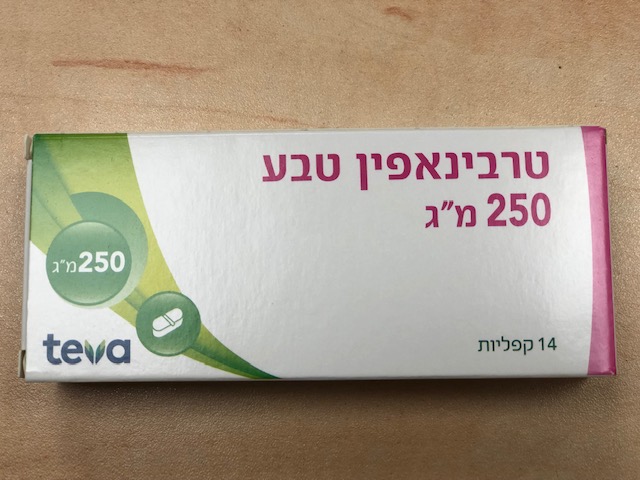Quest for the right Drug

טרבינאפין טבע 250 מ"ג TERBINAFINE TEVA 250 MG (TERBINAFINE AS HYDROCHLORIDE)
תרופה במרשם
תרופה בסל
נרקוטיקה
ציטוטוקסיקה
צורת מתן:
פומי : PER OS
צורת מינון:
קפליות : CAPLETS
עלון לרופא
מינוניםPosology התוויות
Indications תופעות לוואי
Adverse reactions התוויות נגד
Contraindications אינטראקציות
Interactions מינון יתר
Overdose הריון/הנקה
Pregnancy & Lactation אוכלוסיות מיוחדות
Special populations תכונות פרמקולוגיות
Pharmacological properties מידע רוקחי
Pharmaceutical particulars אזהרת שימוש
Special Warning עלון לרופא
Physicians Leaflet
Pharmacological properties : תכונות פרמקולוגיות
Pharmacodynamic Properties
5.1 Pharmacodynamic properties Pharmacotherapeutic group: Oral antifungal agent (ATC code D01B A02) Terbinafine is an allylamine which has a broad spectrum of antifungal activity. At low concentrations terbinafine is fungicidal against dermatophytes, moulds and certain dimorphic fungi. The activity versus yeasts is fungicidal or fungistatic depending on the species. Terbinafine interferes specifically with fungal sterol biosynthesis at an early step. This leads to a deficiency in ergosterol and to an intracellular accumulation of squalene, resulting in fungal cell death. Terbinafine acts by inhibition of squalene epoxidase in the fungal cell membrane. The enzyme squalene epoxidase is not linked to the cytochrome P450 system. When given orally, the drug concentrates in skin at levels associated with fungicidal activity.
Pharmacokinetic Properties
5.2 Pharmacokinetic properties Following oral administration, terbinafine is well absorbed (>70%) and the absolute bioavailability of terbinafine from oral terbinafine as a result of first-pass metabolism is approximately 50%. A single oral dose of 250mg terbinafine resulted in mean peak plasma concentrations of 1.30µg/ml within 1.5 hours after administration. Plasma concentrations decline in a triphasic manor, with a terminal half-life of 16.5 days. At 28 days, when around 70% steady state levels have been achieved, peak concentrations of terbinafine was on average 25% higher and plasma AUC increased by a factor of 2.3 when compared to single dose administration. From the increase in plasma AUC an effective half-life of ~30 hours can be calculated. The bioavailability of terbinafine is moderately affected by food (increase in the AUC of less than 20%), but not sufficiently to require dose adjustments. Terbinafine binds strongly to plasma proteins. It rapidly diffuses through the dermis and concentrates in the lipophilic stratum corneum. Terbinafine is also secreted in sebum, thus achieving high concentrations in hair follicles, hair and sebum rich skins. There is also evidence that terbinafine is distributed into the nail plate within the first few weeks of commencing therapy. Terbinafine is metabolised rapidly and extensively by at least seven CYP isoenzymes with major contributions from CYP2C9, CYP1A2, CYP3A4, CYP2C8 and CYP2C19. Biotransformation results in metabolites with no antifungal activity, which are excreted predominantly in the urine. No clinically-relevant age-dependent changes in pharmacokinetics have been observed but the elimination rate may be reduced in patients with renal or hepatic impairment, resulting in higher blood levels of terbinafine. Single dose pharmacokinetic studies in patients with renal impairment (creatinine clearance <50 ml/min) or with pre-existing liver disease have shown that clearance of oral terbinafine may be reduced by about 50%.

שימוש לפי פנקס קופ''ח כללית 1994
לא צוין
תאריך הכללה מקורי בסל
לא צוין
הגבלות
לא צוין
מידע נוסף
